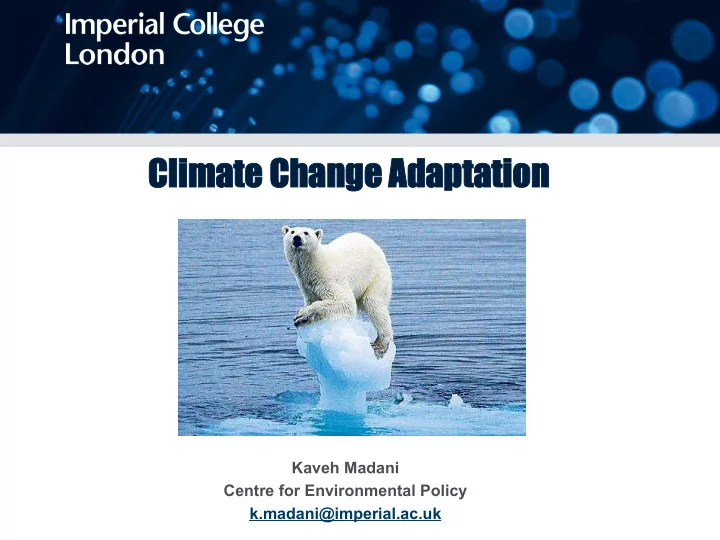

Clima mate Change Adapt ptation Kaveh Madani Centre for Environmental Policy k.madani@imperial.ac.uk
Coupled Human-Natural Systems Multiple subsystems Interactive Dynamic Hydro-Environmental & Energy Systems Analysis Research Group HEESA CEP
Coupled Human-Natural Systems Multiple subsystems Interactive Dynamic Uncertain Hydro-Environmental & Energy Systems Analysis Research Group HEESA CEP
Water Management? • Water • Food • Energy • Ecosystem • Land • Economy • Society • Politics • … Hydro-Environmental & Energy Systems Analysis Research Group HEESA CEP
Studying Impacts vs. Adaptation Hydro-Environmental & Energy Systems Analysis Research Group HEESA CEP
When Should We Adapt? Hydro-Environmental & Energy Systems Analysis Research Group HEESA CEP
How Should We Adapt? Hydro-Environmental & Energy Systems Analysis Research Group HEESA CEP
Ignoring Trade-offs? Global Warming (Symptom) Greenhouse gas emissions Fossil Fuels (Source) Reducing carbon dioxide by any means! Hydro-Environmental & Energy Systems Analysis Research Group HEESA CEP
Trade-offs Carbon footprint Water footprint Land footprint Cost Energy Sources (g CO 2 /kWh ) (m 3 /GJ) (m 2 /GWh) (cent/kWh) Ethanol from corn 81-85 78 10667-12500 2-4 Ethanol from sugar cane 19 99 9520 2-4 Biomass: wood-chip 25 42 14433-21800 4-10 Biomass: miscanthus 93 37 14433-21800 4-10 Solar thermal 8.5-11.3 0.037-0.780 340-680 4-10 Solar photovoltaic 12.5-104 0.042 704-1760 10.90-23.4 Wind: onshore 6.9-14.5 0.001 2168-2640 4.16-5.72 Wind: offshore 9.1-22 0.001 2168-2640 3.64-8.71 Wave and tidal 14-119 0.001 45-120 5-15 Hydropower 2-48 22 538-3068 3.25-12.35 Coal 834-1026 0.15-0.58 83-567 3.77-5.85 Oil 657-866 4.29-8.60 1490 8-10 Natural gas 398-499 0.1 623 5.46-11.96 Nuclear 9-70 0.42-0.76 63-93 4.55-5.46 Geothermal 15.1-55 0.005 33-463 1-8 Hydro-Environmental & Energy Systems Analysis Research Group HEESA CEP
Aggregate Performance Hydro-Environmental & Energy Systems Analysis Research Group HEESA CEP
Some Common MCDM Methods MCDM Method Basis of Selection Pair-wise comparison of alternatives to identify Dominance the non-dominated option (Fishburne, 1964) Maximizing the minimum satisfaction of all Maximin criteria (Wald, 1945) The most desirable alternative for the most Lexicographic important criterion (Tversky, 1969) TOPSIS Minimum distance from the ideal point (Hwang and Yoon, 1981) SAW Highest weighted performance (Churchman and Ackoff, 1945)
Example MCDM Method Basis of Selection Pair-wise comparison of alternatives to identify Dominance the non-dominated option (Fishburne, 1964) Hydro-Environmental & Energy Systems Analysis Research Group HEESA CEP
Who Manages Water? Multiple-Participants Multiple-Objective Hydro-Environmental & Energy Systems Analysis Research Group HEESA CEP
Conflicts Hydro-Environmental & Energy Systems Analysis Research Group HEESA CEP
Prisoner’s Dilemma Bargainin g Hydro-Environmental & Energy Systems Analysis Research Group HEESA CEP
Prisoner’s Dilemma • Lack of trust • Self-optimizer vs. system-optimizer • Free-riding and non- cooperation is a dominant strategy Cooperative resolution is not likely! Hydro-Environmental & Energy Systems Analysis Research Group HEESA CEP
Climate Change Negotiations Hydro-Environmental & Energy Systems Analysis Research Group HEESA CEP
Chicken Hydro-Environmental & Energy Systems Analysis Research Group HEESA CEP
Chicken • Little incentive for cooperation • Free ride and doing the opposite • One winner and one loser • Sending strong signals • Risk tolerance Hydro-Environmental & Energy Systems Analysis Research Group HEESA CEP
Water Management Approaches over Time Hydro-Environmental & Energy Systems Analysis Research Group HEESA CEP
Water Management Models over Time Hydro-Environmental & Energy Systems Analysis Research Group HEESA CEP
Performance Evaluation Hydro-Environmental & Energy Systems Analysis Research Group HEESA CEP
How Do You Make Decisions? • Optimistic • Pessimistic • Expected value • … .. Hydro-Environmental & Energy Systems Analysis Research Group HEESA CEP
How Do You Make Decisions? • Optimistic Robust Decision Making • Pessimistic • Expected value • … .. Hydro-Environmental & Energy Systems Analysis Research Group HEESA CEP
Robust vs. Adaptable Hydro-Environmental & Energy Systems Analysis Research Group HEESA CEP
Reservoir Operations Hydro-Environmental & Energy Systems Analysis Research Group HEESA CEP
Rule Curve Hydro-Environmental & Energy Systems Analysis Research Group HEESA CEP
Reliability How often does your system fail? Hydro-Environmental & Energy Systems Analysis Research Group HEESA CEP
Vulnerability How significant are the likely consequences of failure? Hydro-Environmental & Energy Systems Analysis Research Group HEESA CEP
Resiliency How quickly can your system to a satisfactory state after a failure? Hydro-Environmental & Energy Systems Analysis Research Group HEESA CEP
Trade-offs Again How do you deal with the trade-offs between reliability, resiliency and vulnerability? Hydro-Environmental & Energy Systems Analysis Research Group HEESA CEP
k.madani@imperial.ac.uk
Recommend
More recommend